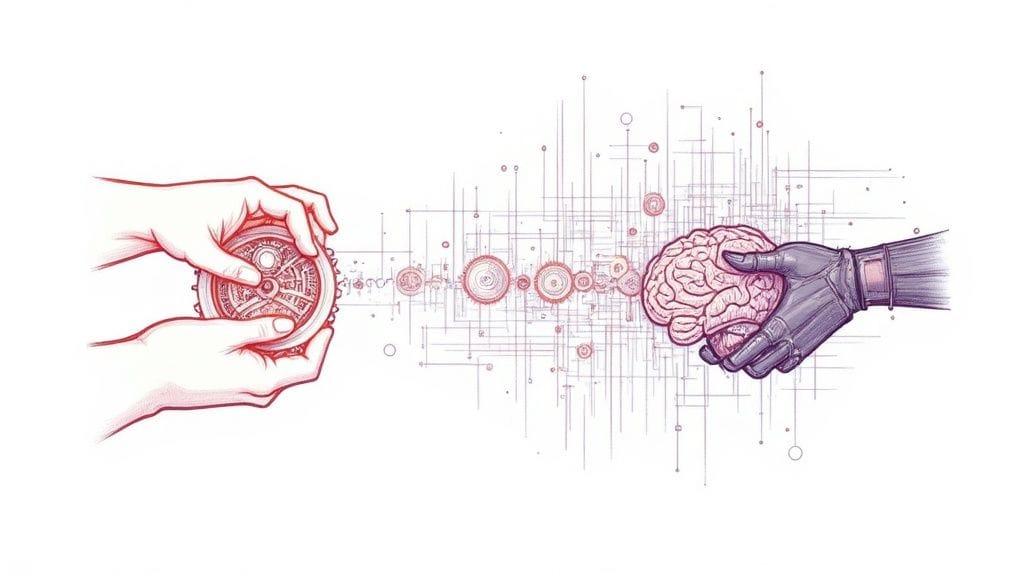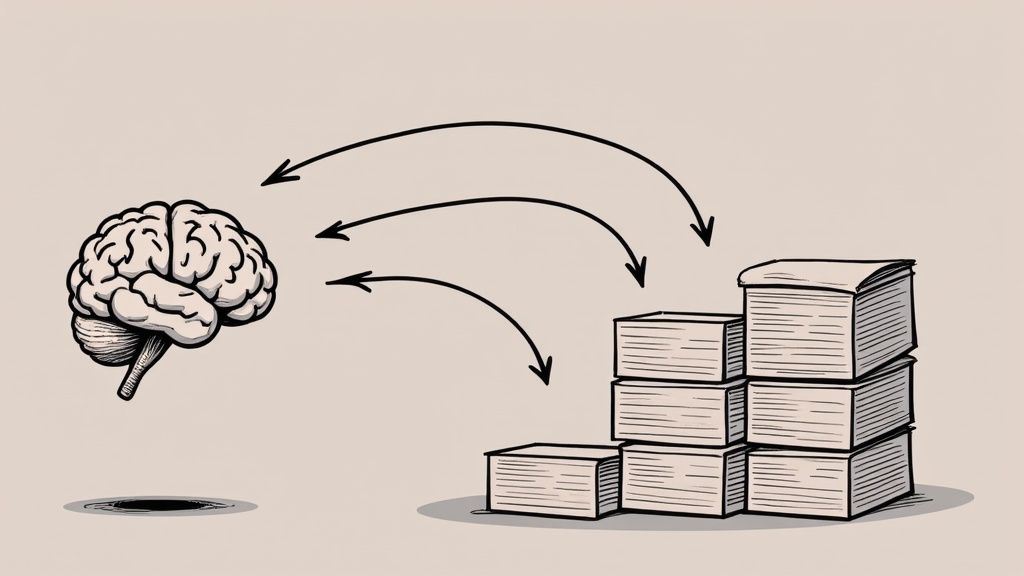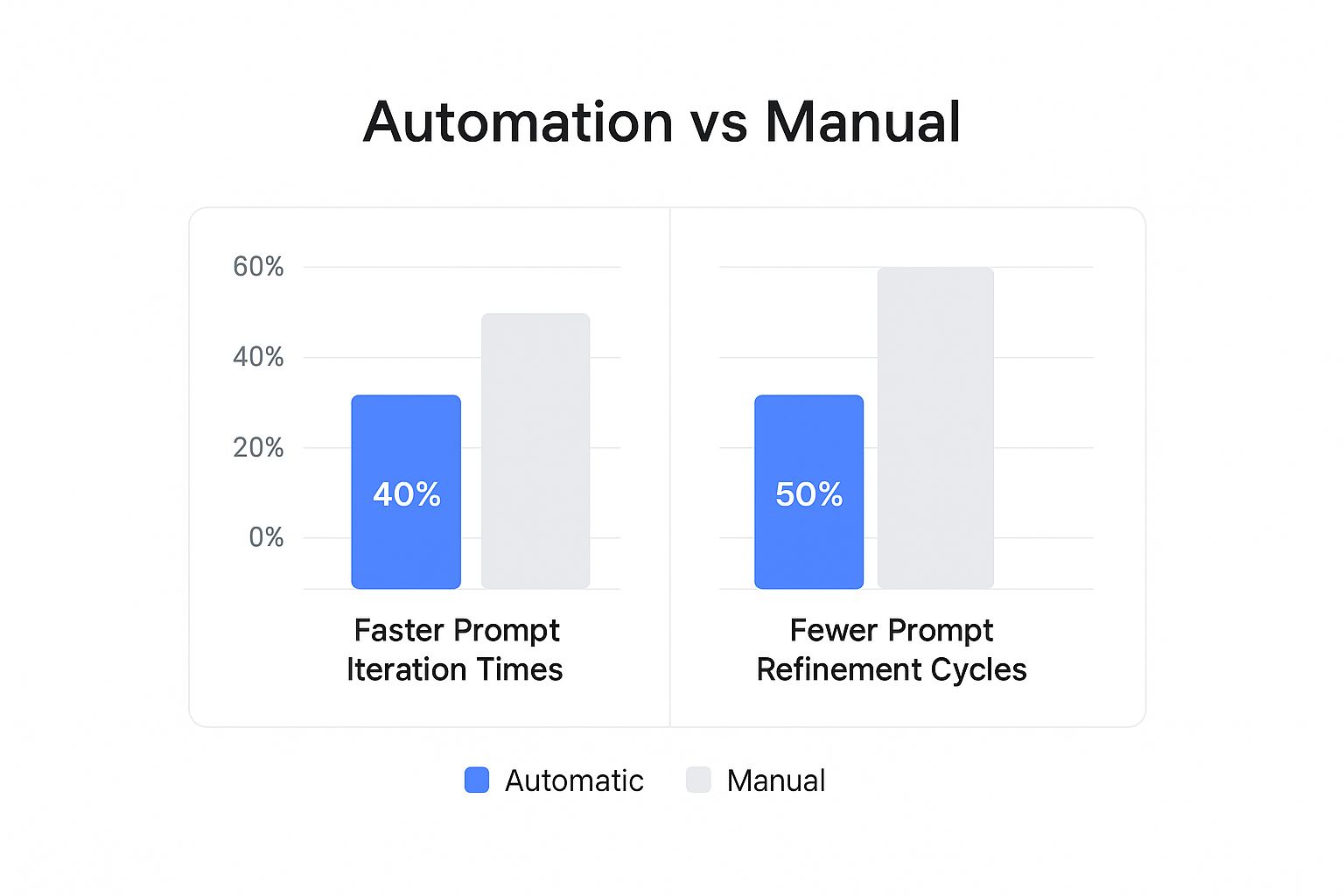Enhancing AI with Automatic Prompt Engineering

Automatic prompt engineering is, at its core, using AI to figure out the best way to talk to other AI models. It’s about ditching the slow, manual process of trial-and-error and letting data-driven systems find the most effective instructions for you.
Essentially, it marks a big shift from hand-crafting individual prompts to building systems that discover them on their own.
From Manual Crafting to Automated AI Prompts

Imagine a master watchmaker, hunched over a bench, meticulously adjusting tiny gears by hand to get the timing just right. That’s a pretty good picture of traditional, manual prompt engineering. It's a craft that demands skill, intuition, and endless tweaking to coax the perfect response from a Large Language Model (LLM). It gets the job done, but it’s painfully slow and nearly impossible to scale.
Now, think of a self-calibrating watch that fine-tunes its own mechanisms for perfect accuracy. That’s the big idea behind automatic prompt engineering. As LLMs get more and more complex, that old-school manual approach just becomes a bottleneck. Finding the ideal mix of words, structure, and context to get a consistently great output is no longer a simple task.
The Shift to Automated Discovery
The real change here is moving from crafting instructions to discovering them. Instead of a person making educated guesses about what might work, an automated system can generate and test thousands of prompt variations. It evaluates each one against a specific goal, picks out the top performers, and keeps refining them until it lands on the best one.
This idea isn't brand new. Its roots trace back to early conversational programs and rule-based query systems. What we're seeing today is a natural progression, where one LLM might generate a batch of candidate prompts, test them on another model, and use a scoring system to pinpoint the most effective instructions. If you want to dive deeper, you can explore the full history and evolution of prompt engineering to see just how far we've come.
This automated approach makes high-performance AI more efficient, consistent, and accessible. It moves beyond human intuition and introduces a systematic, data-driven method for communicating with AI.
Why This Matters for Modern AI
This transition is a game-changer for a few key reasons. Automation can break through the limits of human creativity and our inherent biases. It often uncovers strange but highly effective prompts that a person would never think to try.
For teams building with AI, this means you can:
- Scale AI Operations: You can optimize prompts for dozens of different tasks at once without needing a small army of dedicated prompt engineers.
- Improve Consistency: It helps ensure your AI outputs meet quality standards every single time, which is non-negotiable for things like maintaining a brand voice or building reliable applications.
- Accelerate Development: The time it takes to develop and roll out effective AI-powered features gets cut down dramatically.
Ultimately, automatic prompt engineering is about building smarter systems that help us talk to AI more effectively. It’s what’s needed to set the stage for more powerful and dependable applications.
How Automatic Prompt Engineering Actually Works

Let's break this down with an analogy. Imagine you have a team of two AI assistants: one is a creative "Instructor," and the other is a hard-working "Student." Your job is to get the Student to write a killer marketing email, but to do that, it needs the absolute best instructions possible.
Instead of writing those instructions (the prompt) yourself, you just give the Instructor the final goal: "Get me a marketing email that converts." The Instructor then brainstorms and generates dozens, sometimes hundreds, of different instruction sets for the Student. Some of these prompts might be simple and to the point. Others might be more detailed, using various types of prompting techniques to guide the output.
For every instruction set it creates, the Instructor passes it to the Student, who then writes a marketing email. Now, this is where it gets interesting. A scoring system, which is often another AI or a set of rules you've defined, grades each email. It looks at things like clarity, tone of voice, and how strong the call-to-action is.
The Iterative Refinement Loop
This isn’t a one-shot process. It’s a cycle of constant improvement. The Instructor AI looks at the scores from its first batch of prompts and figures out what worked and what flopped. Did prompts that assigned a specific persona get better results? Did asking for a step-by-step response make the email clearer?
Armed with this feedback, the Instructor creates a new, much smarter batch of prompts. It might mix and match the best parts of the top-scoring instructions or even try completely new angles based on what it learned. This loop of generating, testing, and refining goes on and on, with each cycle getting you closer to the perfect prompt.
At its core, automatic prompt engineering replaces human guesswork with a systematic, high-speed competition. It lets AI models discover the most effective way to communicate with each other through data-driven trial and error.
This automated feedback cycle allows the system to chew through a massive number of prompt variations—far more than any human could handle. While a person might realistically test 10-20 prompts, an automated system can blitz through thousands in a tiny fraction of the time.
Key Mechanical Components
To pull this off, a few key pieces have to work together perfectly. Think of them as the gears inside this self-improving machine:
- Generative Prompt Creation: One AI model is responsible for coming up with a huge variety of initial prompts. This is all about casting a wide net to explore different instructional styles and uncover surprisingly effective approaches.
- Performance-Based Scoring: You need a clear way to measure success. Each output is scored based on specific metrics, whether that's hitting certain keywords, matching a sentiment, or how closely it resembles a perfect example.
- Evolutionary Algorithms: This is the "survival of the fittest" part. The system takes the scoring data to "evolve" the prompts. High-performers are kept and tweaked, while the duds are thrown out. This constantly pushes the system toward the best possible solution.
When all these parts work in sync, the machine systematically refines the prompt's quality, delivering results that are often far better than what you could achieve by hand.
Core Techniques in Prompt Automation
The real power behind automatic prompt engineering comes from a handful of clever techniques that essentially teach an AI model how to think through a problem. These aren't just simple commands; they're frameworks that guide the model from a basic instruction to solving a complex, multi-step challenge.
It all starts with something fairly simple: few-shot prompting. This is where you give the AI a couple of examples to show it what you want. It’s a great way to provide context and demonstrate the output format you’re looking for, but it’s really just the first step on the ladder.
Evolving Reasoning with Chain of Thought
The first major breakthrough in more advanced prompting was Chain of Thought (CoT). The best way to think about CoT is asking the AI to "show its work." Instead of just spitting out an answer, the model is instructed to break down its reasoning process, one step at a time.
For instance, if you give it a math word problem, a CoT prompt encourages the AI to first pull out the key numbers, then explain the steps it's taking to solve it, and only then give the final answer. This simple change makes a huge difference, cutting down on errors and making the AI's logic much easier to follow. We dig deeper into this structured approach in our guide to mastering prompt optimization.
Exploring Possibilities with Tree of Thought
Building on that idea, we have Tree of Thought (ToT), which takes the reasoning process to a whole new level. If Chain of Thought is like following a single, straight road to your destination, Tree of Thought is like exploring a forest with dozens of branching paths.
This technique lets the model explore multiple lines of reasoning at the same time. It can go down one path, realize it’s a dead end, back up, and try a completely different approach. This ability to self-correct and explore alternatives makes ToT incredibly useful for complex problems without a single right answer, like coming up with a business strategy or brainstorming creative ideas.
By blending these techniques, automatic prompt engineering platforms build sophisticated, multi-layered instructions that push AI models to achieve far more than any single, direct prompt ever could.
This visual below really drives home how much faster this automated process is. We're talking about 40% faster prompt iteration and a 50% reduction in refinement cycles.

Those numbers aren't just impressive—they represent real-world efficiency gains that let teams build and launch better AI solutions in a fraction of the time.
The pace of change here is incredible. Just between 2019 and 2025, the field has shot from basic one-off commands to autonomous systems that use methods like CoT and ToT to manage genuinely complex problem-solving. This isn't just an academic exercise; it’s a direct response to a global need for more capable AI, with tech hubs in the US, Europe, and Asia all racing to adopt these newer, smarter methods. Understanding these foundational techniques is the key to building AI that is not just powerful, but also reliable and intelligent.
The Tangible Business Benefits of Automation

Sure, the technology is impressive, but the real magic of automatic prompt engineering is what it does for your bottom line. This isn't just about tweaking AI responses. It's about building a smarter, faster, and more scalable framework for every single one of your AI projects. This shift gives you a serious competitive advantage, and the benefits are crystal clear.
The first thing you’ll notice is a huge jump in your team's efficiency. Let's be honest, manual prompt tuning is a slow, frustrating grind. It ties up your most talented people in a seemingly endless cycle of trial and error. Automating this work breaks that bottleneck, letting your team accomplish far more without burning out. Your best people are suddenly free to focus on big-picture strategy and innovation instead of getting bogged down in tiny adjustments.
Driving Consistency and Quality at Scale
One of the biggest headaches with using AI across a company is keeping everything consistent. Whether it's your brand voice or the quality of customer service, manual prompts can lead to wildly different results. The tone and accuracy can swing from one output to the next.
Automatic prompt engineering fixes this problem by systematically creating prompts that deliver predictable, high-quality results every single time. This kind of consistency is a game-changer for:
- Marketing: Imagine every piece of ad copy, social media update, and email campaign hitting the exact same brand voice.
- Customer Support: Your team can deliver accurate, uniformly toned answers to customer questions, which makes for a much better experience.
- Product Development: You can generate reliable code snippets or documentation that consistently meet your internal standards.
This level of control doesn't just improve quality; it builds trust with your customers and strengthens your brand. You can learn more about getting everyone aligned in our guide to using AI for teams.
By replacing manual guesswork with a data-driven optimization process, businesses can scale their AI applications rapidly without a proportional increase in specialized staff or a decrease in output quality.
Being able to scale like this is what really sets you apart from the competition. The demand for skilled prompt engineers is exploding, with some salaries reportedly hitting $335,000 a year. That number alone shows you how vital this skill has become.
Instead of trying to hire an army of prompt engineers, automation allows you to amplify the impact of the talent you already have. The technology handles the heavy lifting of optimization, making high-performance AI a resource the entire organization can use.
Putting Prompt Automation Into Practice
Alright, enough with the theory. Let's get our hands dirty and see how this actually works. Moving from just talking about automatic prompt engineering to actually doing it can feel like a big leap, but tools like Promptaa are built to bridge that gap.
It all starts with what we call a baseline prompt. This is simply the best prompt you've managed to write by hand for a particular task. Think of it as your champion—the best you've got—which you'll now challenge the system to beat. This gives the whole process a solid starting point and a clear benchmark for success.
First, You Need to Define What "Good" Looks Like
Before you start optimizing, you have to be crystal clear about what you're trying to achieve. If you just tell the system to "make it better," you'll get vague, unpredictable results. You need concrete, measurable goals.
What does a successful output look like for you? It could be a mix of things:
- Keyword Density: Does the AI's response include specific keywords 3-5 times?
- Sentiment Score: Are you aiming for a specific tone? Maybe a sentiment score above 0.8 on a positive scale?
- Format Compliance: Does the output need to be perfect JSON every single time, with no exceptions?
- Readability: Is the goal to write at an 8th-grade reading level, maybe measured by a Flesch-Kincaid score?
These aren't just suggestions; they are the rules of the game. You're giving the automation engine a scorecard to judge every single attempt.
The Promptaa interface, shown below, gives you a clean workspace to manage these prompts. This is where you'd organize your baseline prompts before letting the optimization engine find even better versions.
A well-organized library is ground zero for any serious automation effort.
Kicking Off the Optimization Cycle
Once you've set your baseline prompt and your success metrics, you're ready to hit "go." This is where the magic happens. The platform will take your prompt and begin generating hundreds, or even thousands, of variations.
It’s not just randomly changing words. The system methodically tests different phrasing, tweaks the structure, and even tries out advanced techniques like Chain-of-Thought prompting to see what moves the needle on your metrics. After the cycle runs, you get a ranked list showing the best-performing prompts and the outputs they generated.
The real win here isn't just finding one "perfect" prompt. It's about discovering the patterns that work. You start to see which types of instructions and phrasing consistently get you closer to your goal.
This last part is what separates the pros from the amateurs. When you study the top results, you learn what resonates with the AI model. This insight is gold. It makes you a smarter prompt engineer, helping you craft better and better baseline prompts for all your future projects. This is how you create a powerful feedback loop for continuous improvement in automatic prompt engineering.
So, What Does This Mean for Human-AI Collaboration?
What does a world with self-optimizing AI really look like? The emergence of automatic prompt engineering is fundamentally changing how we interact with these intelligent systems. We're moving away from a simple command-and-response model and into a future where AI acts as a genuine, intuitive partner in our work.
This evolution completely reframes the role of the human expert. The prompt engineer of tomorrow won't be a "prompt crafter" obsessed with tweaking every last word. Instead, they'll be an "AI strategist." Their job will be to define high-level goals, make sense of the performance data, and guide the AI's overall direction, leaving the nitty-gritty optimization to the machine.
Shifting from Tools to Co-Creative Partners
We're headed toward a future where AI doesn't just follow instructions but actively anticipates our needs. Think about an AI that doesn't just sit and wait for the perfect prompt. Instead, it collaborates with you to figure out the best way to tackle a problem, maybe even suggesting different goals or creating its own metrics for success. It becomes less of a tool and more of a creative peer.
The point isn't that humans are being replaced; it's that our abilities are being amplified. AI is becoming a seamless extension of our own creativity, handling the complex optimization so we can focus on the big picture.
Ultimately, this shift will make AI more powerful and accessible for everyone. It’s a future where talking to technology is less about giving rigid, precise orders and more about starting a dynamic conversation to achieve things we couldn't before.
Frequently Asked Questions
It's natural to have a few questions when you're exploring a new way of working with AI. Let's clear up some of the common ones about automatic prompt engineering so you can see exactly how it works and what it can do for you.
What Is Automatic Prompt Engineering in Simple Terms?
Imagine you have an AI model, and you want it to perform a task perfectly. Instead of a person sitting there, manually trying out hundreds of different instructions (prompts) to see what works best, you have another AI do it for you.
This "AI coach" rapidly generates thousands of different ways to ask for something, tests each one against your specific goal, and uses the data to figure out the absolute best prompt. It's all about replacing human trial-and-error with a fast, data-driven system.
Is This Technology Difficult to Implement?
If you were trying to build your own system from scratch, then yes, it would be a huge undertaking requiring a lot of specialized knowledge. But thankfully, that's not the only option anymore.
The good news is that platforms designed for automatic prompt engineering make it incredibly accessible. These tools do all the heavy lifting behind the scenes, giving you a straightforward interface to set up your goals and let the system run. For most companies, using a dedicated platform is the fastest and most realistic way to get started.
The whole point of these platforms is to make advanced AI optimization something any team can do. It lets you focus on your business goals, not the complex mechanics happening under the hood.
Will Automation Replace Human Prompt Engineers?
Not at all. It's much more likely to change the job for the better. Think of it as giving the prompt engineer superpowers. The automation handles the most tedious part of the job—the endless tweaking and testing.
This frees up the human expert to focus on what really matters:
- Defining the business goals and what "success" actually looks like.
- Creating the overall strategy for how AI will be optimized.
- Analyzing the results to find insights that can guide the next project.
The role shifts from a "prompt crafter" to more of an "AI performance strategist," using automated tools to drive better business results.
What Are the Main Advantages Over Manual Prompting?
It really comes down to three huge benefits: speed, scale, and performance. An automated system can test thousands of prompt variations in the time it takes a person to get through a handful. This means you can optimize for many different use cases all at once.
Even better, these systems often discover weirdly effective prompts—phrasing and structures a human would probably never think to try. This can lead to massive jumps in AI accuracy and reliability, getting you to a level of performance that’s nearly impossible to reach manually.
Ready to stop guessing and start optimizing? Promptaa provides the tools you need to implement automatic prompt engineering, helping you discover the most effective prompts for any task. Get started today at https://promptaa.com.